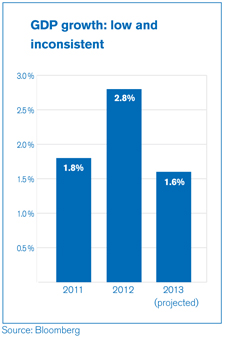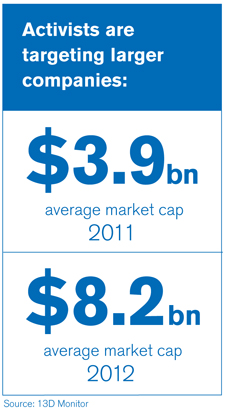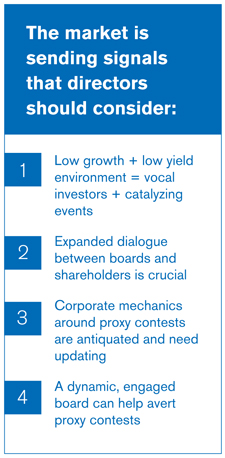
Public company boards have experienced real turbulence for the better part of five years. Some of this turbulence is the product of internal dynamics — the need to improve liquidity, strengthen balance sheets and cut costs. Some is the product of external factors — volatile capital markets and government action and inaction. So, who can blame directors for being cautious? The answer: shareholders and activists.
In response to this turbulence, boards have chosen to seek steady shareholder returns, return shareholder capital and modestly adjust portfolios over executing large-scale transactions, combinations or investments. As a result of this restraint, the overwhelming strength of U.S. corporations is unmistakable: cash balances are at an all-time high and there is an abundance of cheap financing. Yet corporate investment in the economy remains muted.
Directors remain cautious while shareholders are increasingly moving in favor of more aggressive action. The evolving dynamic between boards and the shareholders they serve presents new challenges that require a different set of tools in the boardroom. New efforts to bridge what may be a growing divide between boards and shareholders should be undertaken directly by U.S. boards and management teams with a view toward increasing shareholder value, advancing investment stability, and maintaining sound governance.
Situation Overview
 Competing Economic Forces. The Fed’s easing programs have deepened economic uncertainty, as the potential impact of weaning the economy off what has been historic government intervention becomes a reality. Despite the unprecedented level of government stimulus since the crisis, macroeconomic growth figures remain low and inconsistent, with GDP expected to grow only 1.6 percent this year compared with 2012 growth of 2.8 percent and 2011 growth of 1.8 percent.
Competing Economic Forces. The Fed’s easing programs have deepened economic uncertainty, as the potential impact of weaning the economy off what has been historic government intervention becomes a reality. Despite the unprecedented level of government stimulus since the crisis, macroeconomic growth figures remain low and inconsistent, with GDP expected to grow only 1.6 percent this year compared with 2012 growth of 2.8 percent and 2011 growth of 1.8 percent.
Europe continues to struggle mightily, creating strong headwinds against those invested in, or reliant on, these markets for corporate growth. In the United States, the government regulatory environment, which has tracked an activist path since taxpayer investment in the economy spiked beginning in 2008, is muscular, while its overall scope and law writing process remains unknown. Those watching for increased velocity in the economy continue to wait, as consistent growth is not apparent in the economic numbers that inform decisions in the boardroom.
Shareholders. Shareholders, meanwhile, are pricing in more dynamic corporate activity, with shares of the S&P changing hands at the highest level since the crisis and trading at 14.2 times earnings, above the 5-year (12.9) and 10-year (14.0) averages. Equity funds continue to grow in size and strength. Another signal: shareholders are rewarding companies that have put forward (1) large, core, synergistic acquisitions, (2) tax-driven acquisitions that substantially reduce tax burdens and cost of capital and (3) fundamental separation transactions that unlock value.
While shareholders have rewarded companies that have taken advantage of strategic opportunities, overall M&A activity remains soft. Global M&A activity in the first half of 2013 was at its lowest level since 2004, and many report a deceleration in the M&A market. Both the number of deals and the number of mega-deals have declined, while annualized deal volumes in the first half were behind the pace of the past three years.
Activism
And there is activism — perhaps the clearest signal of the perception gap between boards and shareholders. Activist campaigns, money invested in activist funds and the average size of public company targets are all up. Target size is no longer a deterrent for activists, as the average market cap for target companies has increased from $3.9 billion in 2011 to $8.2 billion in 2012. Gone are the days when shareholder activism was an unfortunate disease that befell smaller, failing companies in need of a swift turnaround. Prudent management, and even profitability, are no longer deterrents to activism.
 Today, the targets of economic and policy activists include some of the largest and most respected corporations in North America, Europe and, of late, Asia. The flow of capital into this new “asset class” is rising: activist funds are estimated to have over $100 billion in assets under management — three times the amount invested in 2008 — with large billionaire family offices and other concentrated pools of private capital behind the scenes as limited partners. Institutional investors, once loath to mix with aggressive and outspoken activists, now routinely take private meetings and share ideas with them.
Today, the targets of economic and policy activists include some of the largest and most respected corporations in North America, Europe and, of late, Asia. The flow of capital into this new “asset class” is rising: activist funds are estimated to have over $100 billion in assets under management — three times the amount invested in 2008 — with large billionaire family offices and other concentrated pools of private capital behind the scenes as limited partners. Institutional investors, once loath to mix with aggressive and outspoken activists, now routinely take private meetings and share ideas with them.
In this environment, traditional corporate communication between directors and shareholders — annual voting, proxy contests, proxy advisory firms and corporate investor relations programs — is inadequate to timely bridge the gap between them, particularly given the opportunity for rapid turnover of the shareholder base as the result of activism. The onus is now on boards to continually monitor their shareholder bases and vigorously advocate their corporate programs and policies.
Historically, direct dialogue between directors and shareholders has been limited to cases in the extreme, i.e., proxy contests, where the atmosphere is confrontational. Boards and management teams often do not develop a meaningful response plan until activists are at the door. Boards that do not engage with their investors on an ongoing basis run the risk of allowing activists to claim the mantle of the catalyst. Activists market change and growth, often showing early stock price returns as short-term investors bid up shares in hopes of profiting from a potential corporate event.
 Our View
Our View
The market is sending several signals that should be considered by directors.
(1) In a low growth and low yield environment, a vocal group of investors will embrace catalyzing events to drive public company share prices. These investors will typically clamor for short-term liquidity options. A longer-term growth plan is likely to generate indifference from shareholders, particularly in contests where a large number of “event driven” hedge funds invest behind a catalyzing strategy. Profit taking on the institutional investor side can often create a new shareholder base dynamic that is unique to proxy contests.
(2) Relations among boards and shareholders of all types should be rethought with an eye toward identifying differences in perspectives in a timely manner. Personal relationships and dialogue between directors and shareholders should be prioritized. Director involvement can and should be developed without interfering with management’s role in advocating the company’s position — often, shareholders are principally concerned with having their views heard by those in the boardroom. Boards that don’t engage with their investors on a continuing basis risk making themselves vulnerable to activists eager to exploit the lack of communication.
(3) The existing corporate mechanics around proxy contests are antiquated and in need of reform. Proxy contests often occur in an atmosphere that is confrontational, and the ad hoc nature of the voting and solicitation process is unlikely to produce good results. Further, in proxy contests, there is a real risk that corporate governance rules will be manipulated to drive a short-term agenda, which carries additional risks for shareholders.
Boards need to have their voices heard in the governance debate and rulemaking process. For example, the SEC is contemplating regulating proxy advisory firms such as ISS and Glass Lewis, which effectively control a large portion of votes in proxy contests. The U.S. Chamber of Commerce, the Business Roundtable and other governance groups are challenging the proxy advisors on issues of transparency and conflict of interest. Directors can and should weigh in on this debate.
(4) Corporate strategy and policy should be clearly communicated and understood in the marketplace. Directors who fail to present a dynamic, engaged board addressing the fundamental issues facing the corporation will create opportunities for those whose investing style is aggressive and short-term. Substance alone is insufficient to address a heavily marketed and focused adversary. Today, presentation, advocacy and direct engagement are required regularly — not merely in response to a contest. Clearly, the overriding objective is to avoid a contest at all.
In this and future issues of Quorum, we will highlight areas where regulatory and enforcement trends present opportunities for action, whether they be collective work at reform, important issues on file with the SEC, DOJ, or Delaware courts, or scenarios where action and direction at the board level can add substantial value.
An abridged version of this article appeared in the Opinion section of The Wall Street Journal on October 10, 2013.